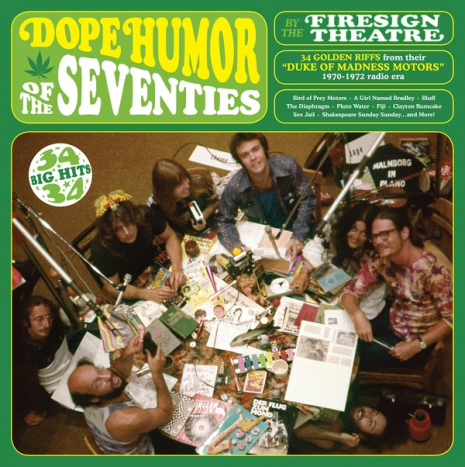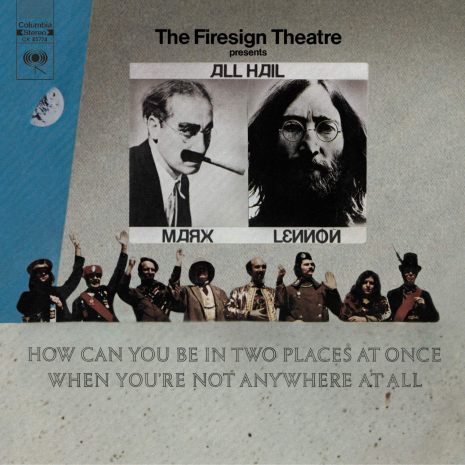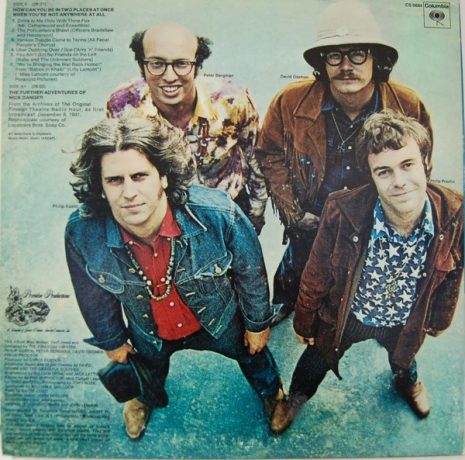
“Discovering the Firesign Theatre is worse than trying to get into Frank Zappa for the first time.”
Anyone who has read this blog for any period of time knows that this is obviously not a place to read, you know, rock journalism. We don’t tend to review things, either. You’ll find scant “criticism” here. I see Dangerous Minds more as a repository of enthusiasm. We write about stuff we enjoy, in the hopes that our fervor will be contagious. “Here is this great thing, you should check it out” is more or less the editorial policy. We almost never write about things we hate. “Hey, smell this, it smells like shit.” There’s no point in that. We’re digital prospectors, panning for gold, not crap.
I’m certain that we’ve introduced our readers to new things that they, in turn, have become evangelists for over the decade plus since DM launched, because you tell us so in the comments. In many ways a DM blog post is like a conversation you might have in a record store. I see it that way. I’ve even had several small record label owners contact me and tell me that they’d put out this or that reissue of an obscure album that we had covered. And that’s fun for us to hear.
So if you are someone who has ever benefited from being introduced to something here that you developed an unhealthy obsession for, pay attention to this, won’t you? This is one of the best things, ever.
I discovered the Firesign Theatre when I was a ten-year-old in 1976, via a long forgotten nationally syndicated radio program called The Comedy Hour which was 60 minutes of short bits from comedy records that were interspersed with bursts of radio static, as if the station was being changed between each selection. It came on Sunday nights at 11pm, right after The King Biscuit Flower Hour, at least on the radio station that I heard it on, Pittsburgh’s WDRE 105.5 FM. The first time I listened to that show, they played an excerpt from the first Firesign Theatre record, Waiting for the Electrician or Someone Like Him, a section known as “Beat the Reaper.” This sketch involved a mock game show where contestants are injected with a fatal disease and have to guess what it is from the symptoms to win the life-saving antidote. If the contestant’s self-diagnosis is incorrect—sorry—they are sent home to die.
I had never heard anything like this. It made my young brain cells stand up to attention the same way hearing “Space Oddity” had the first time I’d heard that.
At the end of the show a zany announcer would tell you who you’d been listening to in a rapidly delivered cascade of names: “On tonight’s Comedy Hour, you heard Lenny Bruce, Albert Brooks, Nichols & May, Franklyn Ajaye, Beyond the Fringe, Moms Mabley, Robert Klein, George Carlin, the Conception Corporation, Jonathan Winters, Bob Newhart, Richard Pryor, Phyllis Diller…” etc., etc., and then he listed Firesign Theatre. I recognized this name since there were several Firesign Theatre albums selling for $1 each in the comedy cut out section of the local National Record Mart. Within a matter of days, I convinced my mother to buy me one titled, Don’t Crush That Dwarf, Hand Me the Pliers.

I instantly became obsessed with that album. I would listen to it over and over again, often with headphones, trying to wrap my 10-year-old mind around it. I listened to Dwarf—and the other Firesign Theatre records—as much as I listened to any musical album. In fact, 45 years later, due to the innate musicality of the work, I still have large chunks of it committed to memory. In this, I am not alone, as there are probably several thousand other people (99% of them upper age bracket baby boomers) who can also recite Firesign Theatre albums as if they were Shakespeare. Dwarf begins with a sermon about food from a demented televangelist broadcasting from a biplane, which crashes. The scene pulls back and it’s a guy watching TV. He’s hungry and looking around for something to eat, but comes up short. He starts talking back to the manic TV evangelist who then starts talking back to him and eventually food comes through the TV screen. The channel changes abruptly. After that there is a This is Your Life-type program with elderly actor George Leroy Tirebiter, and then it morphs into a teen movie play-within-a-play starring a younger Tirebiter called “High School Madness.” Things were going just fine for the students of Morse Science High until their school vanishes, stolen by their rivals, those bullies at Communist Martyrs High School. Porgy Tirebiter and his loveable sidekick Mudhead investigate… you get the idea (hopefully).
Here is a very good description of Firesign Theatre, taken from the pages of Stereo Review magazine, way back in 1993. (Firesign has always been popular with audiophiles.)
A self-contained four-man comedy troupe of writers/actors whose medium was the audio record, they created brilliant, multi-layered surrealist satire out of science-fiction, TV, old movies, avant-garde drama and literature, outrageous punning, the political turmoil of the Sixties, the great shows of the Golden Age of Radio, the detritus of high and low culture (James Joyce meets the found poetry of used-car pitch men) and their own intuitive understanding of the technological possibilities of multi-track recording. Their thirteen albums for CBS, recorded in various group permutations between 1967 and 1975, reveal them to have been at once the Beatles of comedy, the counter-cultural Lewis Carroll, and the slightly cracked step-children of Kafka, Bob and Ray, Jorge Luis Borges, Philip K. Dick, Stan Freberg, Samuel Beckett and the Goon Show.
And as you’ll hear when you play the album you now hold in your hands, they were also far ahead of their time, not just of it. In fact, while most self-consciously “hip” comedy from the late Sixties or early Seventies is as dated now as love beads and black-light posters (listened to Cheech and Chong lately?) The Firesign Theatre, satire - which dealt from the beginning with such unexpected subjects as the implication of cable network narrow-casting (“UTV! For You, the Viewer!”) or New Age pseudo-philosophy (one of their albums was called Everything You Know Is Wrong) - today seems eerily prophetic. In particular, the futuristic vision of Los Angeles - sprawling, fragmented, fear-ridden, multi-cultural, both low rent and high tech - that threads throughout their “oeuvre” (in particular their 1970 masterpiece, Don’t Crush That Dwarf, Hand Me The Pliers) is not only as poetically detailed as anything in Raymond Chandler, but chillingly on the money in 1993.
Firesign Theatre started to assemble during 1966 at KPFK, a freeform stereo FM radio station in Los Angeles, which was then a very new thing, during Peter Bergman’s “Radio Free Oz” show. Phil Austin and David Ossman worked at the station and would appear on RFO, while Philip Proctor, an actor friend the “Wizard of Oz” (Bergman) knew from Yale, was invited to join a bit later. The name refers to the fact that all four were born under fire signs in the zodiac, and to Orson Welles’ Mercury Theatre. The late night Radio Free Oz show was so popular—and they were regularly gigging in Hollywood’s folk and rock clubs—that they were quickly offered a record contract.

There are four undisputed “classics” in the vast Firesign canon, all recorded between 1967 and 1971, titled (in order) Waiting for the Electrician or Someone Like Him, How Can You Be in Two Places at Once When You’re Not Anywhere at All (which includes their most famous creation, “The Adventures of Nick Danger, Third Eye”), Don’t Crush That Dwarf, Hand Me the Pliers, and I Think We’re All Bozos on This Bus. Their first album was recorded in the same CBS radio studio where The Jack Benny Show was taped using vintage microphones and sound effects. By the time of their second record they were using 16-track tape machines in the studio, constructing tightly assembled radio plays with extremely creative sound effects and spatial cues that suggested time travel, watching something at a domed planetarium, being on a people mover, getting into a car where the inside is bigger than the outside and so on. These four records are the ultimate presentation of their unusual artform—literature as much as performed comedy that’s been carefully sculpted in a recording studio—but there are at least 20 other albums, dozens upon dozens of hours of live performances recorded onstage and during their radio shows, and TV and film work. Dear Friends, a 1972 released two record compilation of the best of their syndicated radio show of the same name is also considered to be a classic Firesign album, but being culled from live radio, it’s less elaborately constructed, and more spontaneous and improvisational.
These five albums represent the cream of the crop and they are all masterworks of surrealist “theater of the mind” sci-fi counterculture comedy. There was nothing else like them, and the sole thing I can think of to compare them to would be the Monty Python albums. Firesign Theatre were often called “the American Monty Python,” but this comparison would stop at the Python albums, as Firesign were a strictly audio proposition for the most part, and certainly during their late 60s/early 70s golden years. [They are actually much more akin to lysergic Goon Show, of which all four of the Firesign Theatre were fanatical fans. In fact, Peter Bergman wrote some TV comedy sketches in London with Spike Milligan in the early 1960s.]

A key element to appreciate in Firesign Theatre is how multi-leveled their humor is. For instance, in their famous “Nick Danger” piece, they constantly drop in references to Beatles lyrics such as Danger describing his old flame, Betty Jo Bialosky, who used several aliases—Melanie Haber, Audrey Farber, and Susan Underhill—but “everyone knew her as Nancy” or creepy butler Catherwood walking out of earshot singing “I’m so tired, I haven’t slept a wink.” If you had never even heard of the White Album, these jokes were no less funny, but if you were really in on it, you knew how densely-layered all of this was. “Joycean” is an adjective often employed to describe Firesign, an observation no doubt inspired by the way Molly Bloom’s soliloquy from Ulysses was put into the mouth of manic used car salesman Ralph Spoilsport in his weird rap at the very end of How Can You Be in Two Places at Once When You’re Not Anywhere at All. The relationship of Firesign Theatre to James Joyce’s work is not glib, or overstated. I like to think of the classic FT albums in the same way I regard Joyce’s published books. When airchecks of their (some thought lost) radio shows were collected in the essential Duke of Madness Motors book, I saw this as being analogous to discovering a full trunk of the avant-garde modernist Irish bard’s notebooks. A hundred years from now there will still be graduate students studying the multiple levels of meaning in Joyce and in Firesign Theatre albums.
Did I mention that Firesign Theatre is comedy for smart people? I can’t imagine a dummy even being able to make heads or tails out of it, let alone thinking it was funny. Comedy is almost always made by intelligent people, but theirs was the most intellectual comedy ever made, by some measure. Fifty years later, with all of the comedy that’s washed under the bridge since then, not a single thing—seriously nothing—compares to what Firesign Theatre created. It’s just that distinctive. Their artform cannot be duplicated. Theirs is a uniquely American artform, one that is recognized by the National Registry, and it is theirs alone. Their archive is now housed by the Library of Congress.
Regrettably it’s not that easy to convince people—and I’m talking about one-on-one with friends of mine—to want to get into 50-year-old comedy albums. No one seems to have the attention span. They think it will be dated, but for the most part Firesign Theatre exists in a much more hermetically-sealed and self-referential space than most comedy. There are very, very few outdated cultural references (even in the radio shows), nods to topical events or names that would fail to ring a bell, and 98% of it is as fresh today as it was in 1971. Comedy usually ages very poorly, but this is not the case with Firesign Theatre. A bright 20-year-old armed with an occasional look at Wikipedia would get the vast majority of the jokes, no problem. (As a testament to the long shelf life of their work, there was a fairly recent-ish weekly show of vintage Firesign Theatre radio on WFMU, during drive-time even. It’s evergreen material, I promise you.)
Over the years I have attempted to attract so many converts to the genius of Firesign Theatre, and almost always I have failed. I tend to send out this short clip, of Phil Proctor utterly destroying the rest of them in “The Chinchilla Show.”
[Peter Bergman told me that crazed scenario which I hoped you listened to above, came out of Phil Proctor’s head almost completely spontaneously! The rest of them were just trying to keep up with him. Phil is still like that, btw. When I first met him he told me the story of how he was made an honorary “Kentucky colonel” by the governor of the state while he was attending the Kentucky Derby, and within a matter of two minutes, I was laughing so hard I had tears in my eyes.]
I was able to convince my wife to listen to the four classic Firesign Theatre albums when heavy snowfall saw us (literally) stuck at home for two days, unable to leave. We got high, turned the lights down and listened. She enjoyed all four and told me that she was glad she’d been exposed to it (which was amazingly gratifying to me, I must say.) My other trick is whenever someone is passing through town during a road trip, I’ll burn them some Firesign on a CD-r and tell them not to listen to it until after it’s dark.

The back of the ‘How Can You Be in Two Places at Once’ album cover.
Sadly, my enthusiastic entreaties have invariably fallen upon deaf ears. Most people suppose it’s some sort of 1940s radio show that I am trying to get them to listen to. “Firesign Theatre? Sounds like some old-timey thing.” With others it’s the attention span thing, not enough hours in the day to listen to an hour (gasp!) of spoken word. It recently occurred to me to compare Firesign’s vast oeuvre to podcasts. These days, everybody is always listening to their favorite podcasts, at the gym, in the car, cooking, whatever, they’ve all got a podcast going on in the background. Why not think of the Firesign oeuvre as the greatest comedy podcast ever made?
Well, you’re in luck as all of the major (and much of the minor) works of Firesign Theatre are streaming from the exact same sources as that weekly true crime thing you always listen to. Spotify, TIDAL, YouTube, Amazon Music, Apple Music, all of them are pumping Firesign Theatre directly into your home. The four (or five) classic albums are super easy for you to listen to. Just a few clicks away from where you are reading this…
If any of this has sounded tempting to you, I suggest listening, preferably in the dark, or better still in the dark with headphones on, and stoned as fuck. If not then Firesign is perfect during your commute. Or when you are painting or doing the gardening. The point is that you MUST PAY ATTENTION or you will be lost. Immediately. You cannot multitask. You can’t surf the internet. You can’t be on Twitter or texting. If you don’t pay attention, not only would it be confusing, it would be annoying. I suggest starting where I did, with Don’t Crush That Dwarf, Hand Me The Pliers. Or maybe with “The Further Adventures of Nick Danger, Third Eye.” After that listen to Electrician, the album-length Bozos and the Dear Friends radio show compilation.

For more advanced Fireheads, there’s a brand new release—the first on vinyl in 35 years—titled Dope Humor of the Seventies. The handsomely designed two-record set—produced by longtime Firesign Theatre associate, my pal Taylor Jessen—includes 83 minutes of material, with a further hour or so that can be downloaded online, or streamed at all of the usual places. The collection was culled from their Dear Friends, Let’s Eat and The Firesign Theatre Radio Hour Hour series, and there’s an insert with excellent liner notes that begins with the (absolutely true) statement I quoted at the start: “Discovering the Firesign Theatre is worse than trying to get into Frank Zappa for the first time.” Yes, it might seem daunting that there are well over 100 hours of Firesign Theatre to wade through, but if you think of these albums and radio shows the same way you think about podcasts, and you start with what I suggest, you might just discover something that you’ll obsess over for the rest of your life. I reckon that a high percentage of you who have read this far will be wondering “where has this been all my life?” unless you are already a Firesign Theatre fan, of course,
Seriously, just spark one up, turn out the lights and listen to this. Do it. Do it now…
from Hacker News https://ift.tt/3lWee4G
No comments:
Post a Comment
Note: Only a member of this blog may post a comment.